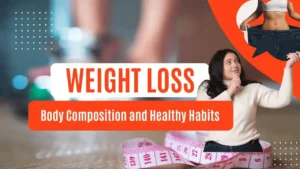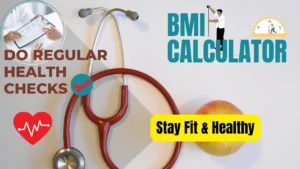The healthy body fat percentages based on age:
Aged 20 to 39: women should aim for 21% to 32% of body fat. Men should have 8% to 19%
For people 40 to 59: women between 23% to 33% and men should fall around 11% to 21%
Aged 60 to 79: women should have 24% to 35% body fat, and men should have 13% to 24%
Source: American Journal of Clinical Nutrition
Losing weight is a common thing for numerous people. It can be a challenging journey, especially when you are unsure where to start. Understanding body composition and developing healthy habits are two essential factors of a successful weight loss plan. This composition will discuss the basics of weight loss, the different types of body composition, and some healthy habits that can help you reach your weight loss aims.
Table of Contents
ToggleThe Basics of Weight Loss
Losing weight is simply the process of burning further calories than you consume. This can be achieved through a combination of diet and exercise. Still, weight loss isn’t as straightforward as it may feel. Numerous factors, like genetics, age, and life habits, can affect weight loss.
Calories in vs. Calories Out
Calories in vs. Calories out is the foundation of weight loss. To lose weight, you must produce a calorie deficiency, which means burning additional calories than you consume. One pound of fat equals 500 calories. Thus, to lose one pound per week, you must create a deficiency of 500 calories per day.
Macro and Micronutrients
Macronutrients are nutrients that the body requires in large quantities, similar as carbohydrates, protein, and fat. Micronutrients are nutrients that are needed in lower quantities, similar as vitamins and minerals. A balanced diet should include a variety of macronutrients and micronutrients to support overall health.
The part of Exercise
Exercise is an important element of a weight loss plan. It can help you burn more calories, increase muscle mass, and improve overall health. Incorporating cardiovascular and strength training exercises into your routine can help you achieve your weight loss aims.

Understanding Body Composition
Body composition refers to the body’s fat, muscle, and bone volume. There are different types of body composition, and each has its own implications for health.
Body Mass Index( BMI)
Body Mass Index( BMI) measures body fat based on height and weight. It’s an extensively used system to determine whether someone is underweight, normal, overweight, or obese. Still, BMI has limitations and doesn’t consider muscle mass or body composition.
Your BMI Calculator
BODY MASS INDEX (BMI)
Your BMI is......
| BMI | Classification |
|---|---|
| less than 18.5: | Underweight |
| 18.5 - 24.9: | Normal weight |
| 25 - 29.9: | Overweight |
| 30 - 34.9: | Class I Obese |
| 35 - 39.9: | Class II Obese |
| 40 upwards: | Class III Obese |
Body Fat Percentage
Body fat percentage is the chance of fat in the body. It’s a more accurate measure of body composition than BMI, as it considers muscle mass and body fat. A healthy body fat percentage varies grounded on age and gender.
Waist- to- Hip Ratio
Waist-to-hip rate is a measure of the distribution of body fat. It’s calculated by dividing the waist circumference by the hip circumference. An advanced waist-to-hip ratio is associated with an increased threat of health problems like cardiovascular disease and type 2 diabetes.
Healthy Habits for Weight Loss
Developing healthy habits is essential for long-term weight loss success. Then are some habits that can help you achieve your weight loss aims.
Mindful Eating
When it comes to losing weight, we frequently concentrate solely on what we eat and how important we eat. still, we should also pay attention to how we eat. Mindful eating is a practice that encourages us to be present in the moment and apprehensive of our food choices and eating habits. By rehearsing mindful eating, we can enjoy our meals more, feel more satisfied, and eventually consume smaller calories.
To exercise mindful eating, concentrate on your hunger and fullness cues. Before you eat, ask yourself if you’re truly empty or if you’re eating out of tedium, stress, or habit. During your meal, savor each bite, chew slowly, and concentrate on your food’s taste, texture, and smell. Put down your implements between mouthfuls and take a moment to breathe and reflect on your passions. When you’re satisfied, stop eating.
Another aspect of mindful eating is being apprehensive of your feelings and how they affect your eating habits. Many people turn to food for comfort or as a managing mechanism for stress, anxiety, or other feelings. By recognizing your emotional triggers, you can develop healthier managing strategies and break the cycle of emotional eating.
Exercise
Exercise is an essential element of any weight loss plan. Not only does it burn calories and boost metabolism, but it also improves mood, reduces stress, and promotes overall health and well-being. Finding an exercise routine you enjoy and can stick to over time is key.
When it comes to weight loss, cardio is frequently the go-to exercise. Running, biking, swimming, and other cardio activities effectively burn calories and enrich cardiovascular health. Still, strength training is also important for weight loss. By constructing muscle, you can increase your metabolism and burn further calories when resting.

Incorporating exercise into your day-to-day routine can be as simple as taking a brisk walk or doing a quick bodyweight exercise. Aim for at least 150 minutes of moderate-intensity exercise per week, or 75 minutes of vigorous exercise per week. You can also break up your exercise into lower chunks throughout the day if you have a busy schedule.
Adequate Sleep
Sleep is frequently overlooked when it comes to weight loss, but it’s just as important as diet and exercise. Lack of sleep can disrupt hormones that regulate appetite and metabolism, leading to increased hunger, cravings, and weight gain. On the other hand, getting enough sleep can help you feel more reenergized, reduce stress, and make better food choices.
Grown-ups should aim for 7- 9 hours of sleep per night. To upgrade your sleep habits, establish a harmonious sleep schedule, produce a comforting sleep environment, and avoid defenses and stimulating activities before bed.
Stay hydrated
Drinking water throughout the day can help you feel full and help prevent overeating. Aim for at least eight glasses of water daily, and further if you exercise or in a hot climate.
Manage Stress
habitual stress can lead to overeating and weight gain. Practice stress-reducing activities similar as meditation, deep breathing, or yoga to help manage stress and ameliorate your overall well- being.
Losing weight can be challenging but attainable with the right mindset and tools. By understanding your body composition and embracing healthy habits similar as eating a balanced diet, staying hydrated, exercising regularly, getting enough sleep, managing stress, seeking support, setting realistic aims, tracking your progress, being kind to yourself, and celebrating your successes, you can achieve sustainable weight loss and improve your overall health. Remember, weight loss is a journey, not a destination, so be patient and patient. Good luck on your weight loss travel!
FAQ
Yes, you can lose weight without exercise by creating a calorie deficit through diet alone. However, exercise can help you burn more calories, build muscle, and improve overall health and well-being.
The amount of weight you can lose in a week depends on a variety of factors, including your starting weight, diet, exercise habits, and metabolism. In general, a safe and sustainable rate of weight loss is 1-2 pounds per week.
Some foods that are commonly associated with weight loss include fruits and vegetables, lean protein, whole grains, and low-fat dairy. However, there is no one-size-fits-all approach





